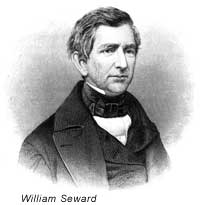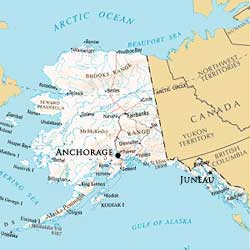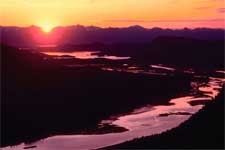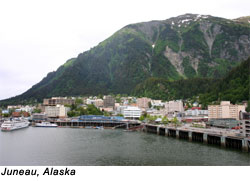 
Seward's Folly: Russia sold Alaska to Secretary of State William Seward in 1867 for $7.2 million -- that's about 2 cents per acre. Alaska became known as "Seward's Folly" or "Seward's Iceberg" because many Americans thought he had spent too much for what they considered a frozen wasteland. When Alaska became the 49th state in 1959, it was the first state to enter the Union in 47 years. It also increased the country's area by a fifth.
Frozen wasteland?: Not at all. Alaska had an abundance of natural resources. Even today, it still has the largest fishing industry in the United States, thanks to its massive supply of salmon, halibut, shrimp, and Dungeness crab. Moreover, Alaska had gold. The first major influx of Americans to Alaska occurred during the gold rush of the 1890's.
Furthermore, in 1968, a huge 10-billion-barrel oil field was struck in Alaska at Prudhoe Bay. In 1977, the Trans-Alaska Pipeline was completed to carry oil across the state. At about 800 miles in length, the pipeline cost $8 billion to build. The pipeline was a success. In fact, so much revenue resulted from oil that the state abolished its personal income tax.

 Alaska is a Pacific state bordered by the Bering Sea to the west, the Arctic Ocean to the north, the Yukon Territory to the east, and the Pacific Ocean to the south. It is the northernmost state. The state shares the Yukon River, a 1,979-mile long river that is frozen several months each year, with Canada. Alaska is the largest state in the United States. However, it is the second smallest in population; only Wyoming has fewer residents. Because Alaska is so large and has so few people, each resident could own his own square mile of land. Alaska is a Pacific state bordered by the Bering Sea to the west, the Arctic Ocean to the north, the Yukon Territory to the east, and the Pacific Ocean to the south. It is the northernmost state. The state shares the Yukon River, a 1,979-mile long river that is frozen several months each year, with Canada. Alaska is the largest state in the United States. However, it is the second smallest in population; only Wyoming has fewer residents. Because Alaska is so large and has so few people, each resident could own his own square mile of land.
Separated from Asia by the Bering Strait, Alaska is closer to Asia than any other state. Russia is only about 51 miles away from the state's mainland; Russia's Big Diomede Island is only about 2.5 miles away from Alaska's Little Diomede Island.
If you like extremes, Alaska is the place for you. The state is known as a land of extreme contrasts because it has frozen glaciers as well as hot springs, temperatures as low as -80 degrees F and as high as 100 degrees F, and isolated villages as well as modern cities. Alaska is the coldest state. In Fairbanks, the high temperature in January averages only -2 degrees F.
 The length of daylight is also extreme. The summer sun shines for almost 20 hours a day in Alaska. At Point Barrow, the sun does not set from May 10 to August 2. That's why Alaska is known as the "Land of the Midnight Sun." However, during part of the winter, there is constant darkness at Point Barrow. The length of daylight is also extreme. The summer sun shines for almost 20 hours a day in Alaska. At Point Barrow, the sun does not set from May 10 to August 2. That's why Alaska is known as the "Land of the Midnight Sun." However, during part of the winter, there is constant darkness at Point Barrow.
How about some more extremes? Mount McKinley, at 20,320 feet above sea level, is the highest mountain in the country. Alaska also has more coastline than any other state.

Alaska is valuable for other reasons. Radar stations in the state protect Americans from a sneak attack over the North Pole. Anchorage, Alaska's largest city, is known as the "Air Crossroads of the World" because of its strategic location; it serves as a refueling base for flights between Asia and Europe and between the United States and Asia.
 Other cities in Alaska include Juneau and Sitka. Juneau is the state capital, but if you visit, you'll have to travel by plane or boat since there aren't any roads going into the city. At 4,710 square miles, Sitka is the largest city in area in the country. The Alaskan Islands of Attu and Kiska were captured by the Japanese during World War II. Other cities in Alaska include Juneau and Sitka. Juneau is the state capital, but if you visit, you'll have to travel by plane or boat since there aren't any roads going into the city. At 4,710 square miles, Sitka is the largest city in area in the country. The Alaskan Islands of Attu and Kiska were captured by the Japanese during World War II.
Bush pilots bring Inuits, or Eskimos, living in remote villages their supplies. You can see Inuit still driving their traditional dog sleds to hunt caribou and polar bears. But go soon because snowmobiles are rapidly replacing the dog sleds. Speaking of dog sleds, a famous international dog sled race takes place in Alaska on the Iditarod Trail.
Visit the Valley of Ten Thousand Smokes, named for the smoke and gas that rises from the fumaroles, or volcanic vents. Alaska has more active volcanoes than any other state. But if you're in Alaska, be careful. It's very easy to get lost in the state's Arctic regions during a "white out" when blowing snow makes it impossible to tell land from sky.
Alaska gets its name from an Aleutian word that means "peninsula," "great lands," or "land that is not an island." The Aleuts are people who live on the Aleutian Islands, which lie off Alaska's mainland. The state is also known as the "Last Frontier" because man has not yet explored all of its vast land where killer whales, moose, walrus, kodiak, and polar bears live in the wild. The abbreviation for Alaska is AK.
|

![]()
